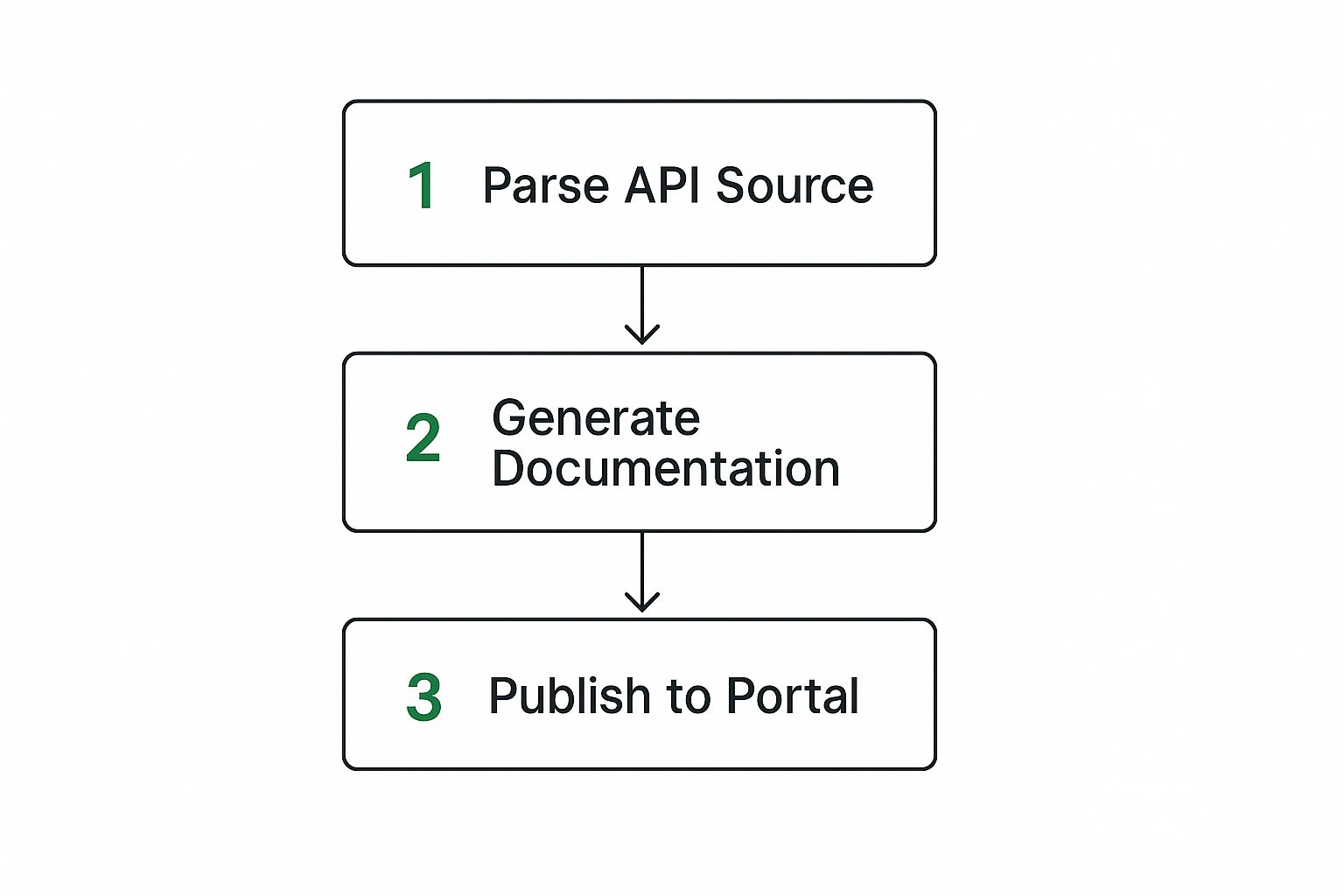Learn how automatic API documentation simplifies development with top tools and tips. Create accurate docs effortlessly and boost productivity.
Automatic API documentation is exactly what it sounds like: a process where specialized tools generate and update your API reference guides straight from the source code or API specifications. This approach ensures your documentation is always accurate and perfectly in sync with every single code change, giving your developers their valuable time back.

Imagine you’re a cartographer, meticulously hand-drawing a map of a city where new roads appear and old ones vanish every single day. That’s what manual API documentation feels like in modern software development—a constant, exhausting battle against outdated information, human error, and versioning chaos.
Before we dive into those challenges, it helps to be on the same page about what an API is. At its core, an API is a set of rules that lets different software applications talk to each other. When those rules change, the documentation has to reflect it instantly.
If it doesn’t, the consequences ripple through your entire development ecosystem. You get a whole mess of confusion, integration failures, and frustrating delays. Developers are left trying to decipher cryptic endpoints or just guessing how a new feature works, burning hours that should be spent building great products.
The fundamental issue with manual documentation is that it’s almost guaranteed to go stale. One forgotten update after a deployment can make the whole document unreliable. This creates a trust deficit between your API and the people who use it, whether they’re on your own team or external partners.
This problem is only getting bigger as development gets faster. The rise of AI has completely reshaped the API world, with projections showing a massive 73% increase in AI-related API calls by 2025. In this environment, doing things by hand is a serious bottleneck.
To see the stark contrast, let’s compare the two approaches side-by-side.
This table lays out the key differences between the old, manual way and the modern, automated approach.
The differences are pretty clear. One path leads to constant catch-up and frustration, while the other paves the way for efficiency and reliability.
Switching to automatic API documentation isn’t just a nice-to-have; it’s a strategic necessity. It transforms documentation from a chore everyone dreads into a reliable, living asset that grows and changes right alongside your code. This automated method ensures everyone has access to a single source of truth.
This transition solves several critical pain points that plague manual processes:
By understanding just how painful the “before” is, we can truly appreciate the power of the “after.” The business need is clear—we need a smarter way to keep our documentation and development in perfect sync.
So, how does raw code magically turn into clean, interactive documentation? It’s not actually magic, but the process is surprisingly logical. Think of these automation tools as diligent scribes who constantly watch your codebase, noting every change without ever needing to be told.
The process kicks off when a tool parses your API’s source code. It scans through your files, hunting for specific clues you’ve intentionally left behind. These clues are often annotations or specially structured comments, like JSDoc for JavaScript or JavaDoc for Java. The tool then pulls out all that juicy metadata—descriptions, parameter details, and data types—straight from the code itself.
This approach is powerful because it ensures your documentation is born from the exact same source as your application’s logic. It’s not some separate, disconnected Word doc that can fall out of date. Instead, it’s a living, breathing reflection of how your API actually works right now.
For this whole system to click, both humans and machines need to speak the same language. This is where the OpenAPI Specification (OAS) comes in. It’s the universal blueprint for describing RESTful APIs, and it plays a central role in this entire process.
By translating all those extracted code comments and structural details into the OpenAPI format, these tools create a standardized, machine-readable definition of your API. This definition file, usually in JSON or YAML format, contains everything a developer could possibly need to know:
/users/{userId}.This standardized file becomes the single source of truth. It’s the master plan that every other process can rely on. If you want to dive deeper into the nuts and bolts, check out our guide on how to auto-generate API documentation.
Once that OpenAPI file is generated, the final step is to render it into a format that’s actually useful for humans. This is where you see the real payoff. The tool takes the structured data from the specification and builds a slick, interactive documentation portal.
This simple but powerful workflow is visualized below.

What this really shows is a continuous cycle. The source code is the definitive origin, which guarantees the published documentation is never out of sync. This isn’t just a one-and-done conversion; it’s a dynamic, ongoing process.
You end up with a seamless feedback loop. Changes to endpoints, parameters, or data models are instantly captured and presented in a clean, easy-to-navigate interface. This is the core engine behind modern automatic API documentation. It turns what used to be a mind-numbing chore into a reliable, automated asset that empowers your entire team, builds trust, and accelerates development by providing a single, always-accurate reference point.

Shifting to automatic API documentation is way more than a simple workflow tweak. It’s a genuine strategic decision that pays dividends across your entire business. While the most obvious win is saving your developers a ton of time, the real magic happens in how it elevates the whole development lifecycle and makes your API more competitive.
This move flips the script, turning documentation from a painful chore into one of your most powerful assets. When you get rid of the mind-numbing manual updates, you unlock massive gains in productivity, accuracy, team collaboration, and even how quickly your API gets adopted. Let’s dig into the real-world benefits you see when automation takes over the grunt work.
One of the biggest wins right out of the gate is the ability to seriously improve developer productivity. It’s shocking how much of an engineer’s day can get eaten up by writing, tweaking, and fixing documentation. Automate that process, and you hand all those hours back to them to focus on what they do best: building features, innovating, and squashing bugs.
Instead of constantly switching gears to update a reference guide every time they make a small change, developers can stay in the zone, writing great code. The documentation just keeps up in the background, generated directly from the code itself. This isn’t just a small efficiency gain; it leads to faster development cycles and a much happier team.
Let’s be honest—manual documentation is a breeding ground for human error. A forgotten parameter, a typo in an endpoint, or an outdated example can send an API consumer down a rabbit hole of frustrating debugging that lasts for hours.
Automatic generation wipes out this entire category of problems.
This consistency is everything. When developers trust your docs, they can build integrations confidently, knowing that what they’re reading is exactly what they’ll get. That kind of reliability is the bedrock of a great developer experience. For a closer look at building this kind of trust, check out our guide on API documentation best practices.
Picture a new developer joining your team. With a manual system, they might spend their first week lost in a maze of half-updated wikis and conflicting Word documents, just trying to figure out how your APIs work. It’s a slow, painful start.
Now, imagine they get access to an automated, interactive portal from day one. It’s a single source of truth that’s always up-to-date. They can explore endpoints, click through data models, and even fire off test calls right in the browser. This slashes their ramp-up time, helping them become productive members of the team in days, not weeks.
Great documentation isn’t just a technical necessity; it’s a killer marketing tool. In fact, surveys show that over 80% of developers say clear, easy-to-understand documentation is a major factor when choosing a new API. Top-tier docs have a direct impact on your API’s adoption rate and success in the market.
Automation also brings your internal teams closer together. Frontend and backend developers are no longer working off different playbooks. They share one common, always-accurate reference point, which leads to some fantastic outcomes:
In the end, all these benefits feed into each other. Higher productivity leads to faster releases. Faster releases, backed by accurate docs, drive more adoption. And better adoption with smoother collaboration creates a powerful, self-reinforcing cycle of development excellence.
Picking the right tool for automatic API documentation isn’t just about ticking boxes on a feature list. It’s a decision that echoes through your team’s entire workflow and ultimately defines how good your final docs are. The market is packed with options, but they are absolutely not one-size-fits-all. The best choice is deeply personal to your tech stack, your team’s philosophy, and what you’re actually trying to achieve.
To make a smart choice, you have to look past the marketing noise and understand the core philosophy behind these tools. The biggest fork in the road is the code-first vs. design-first debate.
A code-first workflow is exactly what it sounds like: your documentation is born directly from comments and annotations in your source code. This is perfect for teams that live and breathe agile development, where you want the docs to be a mirror image of the codebase, updated in real-time. On the flip side, a design-first approach means you meticulously plan and define your API in a specification before a single line of code is written. This is the go-to for ensuring rock-solid consistency, especially when you’re planning large, complex systems or public-facing APIs.
This decision sets the tone for everything that follows. A team cranking out internal microservices will probably love the speed of a code-first tool. But a company building a public API for big enterprise clients? They’ll likely lean on a design-first tool to map out every endpoint and response with precision.
To get practical, let’s look at some of the heavy hitters and where they shine. Each tool brings something unique to the table, from scrappy open-source flexibility to polished, all-in-one platforms.
Here are a few popular options you’ll run into:
Getting a feel for these differences is the first step. The tool you pick will shape not just how your team works together, but how the outside world experiences your API.
The landscape of automatic documentation tools is diverse, with each option offering a distinct approach. The table below breaks down the key differences between a few leading solutions to help you see where they fit.
This comparison highlights that your choice depends heavily on whether you prioritize flexibility, presentation, or upfront design collaboration.
While the tools we’ve discussed are great at generating the technical skeleton of your docs, a new wave of solutions is here to do much more. AI-powered platforms are changing the game. They don’t just generate documentation; they actively make it better.
Tools like DocuWriter.ai are leading this charge. Instead of just dumbly parsing code comments, these platforms use AI to inject much-needed context, write human-friendly descriptions, and produce docs that actually teach developers how to use your API. An AI can analyze an endpoint and suggest genuinely helpful explanatory text, making the final output worlds clearer and more useful. For anyone with a complex API, this AI-driven enrichment is a lifesaver.
This directly solves one of the biggest complaints about traditional auto-generated docs: the lack of narrative. An AI-powered system can bridge that gap by suggesting tutorials, explaining use cases, and ensuring your documentation feels less like a sterile reference and more like a helpful guide. This is the next leap forward in creating a truly great developer experience.
If you’re weighing your options, you owe it to yourself to see what a modern API documentation generator can do. These intelligent tools don’t just save you time on generation; they automate the genuinely hard part: writing clear, instructive content that people will actually want to read.

A powerful tool is only as good as the strategy behind it. When you decide to bring in automatic API documentation, you’re not just buying a piece of software. You’re weaving a new process into the very fabric of how your team builds things. Done right, documentation stops being a chore and becomes a real strategic asset.
The whole point is to build a system where great documentation just happens as a natural part of your development flow. It’s about more than just spitting out a reference guide; it’s about thinking through how that guide gets created, kept up-to-date, and actually used by people. Without a solid plan, even the most impressive tool can end up collecting digital dust.
Let’s walk through some practical steps to get this right, avoid the common stumbles, and make sure your documentation is always accurate, easy to find, and genuinely helpful.
First things first: you need a single source of truth. For modern APIs, that’s your OpenAPI Specification file. Think of it as the official blueprint for your API. Every single tool, process, and person on your team should treat this file as the final word on how the API works.
When you commit to this, you kill ambiguity at the source. The frontend team, the backend team, and the QA engineers are all looking at the same blueprint, which cuts down on a ton of integration headaches and “I thought you meant…” conversations. Any change—whether to an endpoint, a parameter, or a response—has to happen in this central file first. This keeps the contract between your API and its consumers clear and consistent.
Automation is brilliant at pulling out the technical nuts and bolts, like endpoint paths and data types. What it can’t do is explain the why. That’s where your developers come in. By adding clear, human-friendly descriptions right inside their code comments or annotations, they provide the context that machines just can’t guess.
This isn’t about adding a bunch of extra work. In fact, it encourages developers to think more clearly about their own API design and makes the code itself easier for the next person to pick up. The result is documentation that doesn’t just tell you what an endpoint does, but teaches you how to use it effectively.
For automation to be truly automatic, it has to be continuous. The best way to make that happen is to plug your documentation generation right into your Continuous Integration/Continuous Deployment (CI/CD) pipeline. This is the secret to creating truly “living” documentation that never gets stale.